Explore Shikoku by embarking on a spiritual journey: the Shikoku 88 temple pilgrimage. Discover the living culture, historic tradition, and gorgeous landscapes along the path to enlightenment as you visit Shikoku’s 88 temples found in the four prefectures of Tokushima, Kochi, Ehime, and Kagawa.
Shikoku is home to abundant nature, stunning landscapes, friendly local people, and rich culture and history. Not on everyone’s bucket list, Shikoku remains largely untouched and one of the most stunning places in the country. This pilgrimage loop of 1,200 kilometers will take you into Shikoku to experience the land as few do.
What is the Shikoku 88 temple pilgrimage?
The Shikoku pilgrimage, or Shikoku henro, is a well-known circular pilgrimage route that hundreds of thousands undertake annually. Traditionally, pilgrims will journey by foot but the modern-day pilgrim is welcome to use any mode of transportation, of course.
The history of pilgrimages in Japan dates back to at least the Heian period (794-1185), as they have always been an important aspect of Buddhist practice. The Shikoku 88 temple pilgrimage is associated with a Buddhist monk named Kukai who was born at the 75th temple on the path.
Known also by his posthumous name, Kobo Daishi, Kukai was influential in promoting Buddhism in Japan and is lauded for his many achievements. The Shikoku 88 temples are all places that Kukai is believed to have visited, studied, or worshipped at. Along with the main 88 temples, there are dozens of lesser temples along the way that also creates a serene atmosphere of spirituality for any pilgrim.

Where to start the pilgrimage?
There are many ways to visit the temples and no two pilgrims will have the same experience. In fact, some even consider visiting the temples in reverse order to be lucky while others first visit Mount Koya in Wakayama Prefecture to begin their journey. Completing the pilgrimage can take up to two months if done by foot as the entire length is 1,200 kilometers or 750 miles!
The pilgrimage is a physical metaphor for the path to enlightenment and, as such, the temples represent the Buddhist path itself. Temples 1 to 23 represent awakening (hosshin), 24 to 39 relate to discipline (shugyo), 40 to 65 represent attaining enlightenment (bodai), and finally, 66 to 88 are entering nirvana (nehan).
With this progression of the temples, your journey of enlightenment will be a lifelong memory of Japan and your spirituality. Whether you visit eight temples on a mini-pilgrimage or all eighty-eight, it’s sure to become a deeply personal experience.
Popular Shikoku 88 pilgrimage routes
From Mount Koya (Wakayama)
Thanks to being first settled by Kukai in 819 CE, Mount Koya has heavy ties to Buddhism in Japan and makes it a great place to begin your pilgrimage. From Mount Koya to the first temple of the Shikoku 88 is a 4.5-hour trip by bus and train.
From Ryozenji (#1, Tokushima)
This is the traditional route. By beginning in Tokushima and traveling through the 88 temples, you’ll follow in the footsteps of the pilgrims who came before you and have a traditional pilgrimage experience.
From Okuboji (#88, Kagawa)
A gyaku-uchi (backward) voyage of the Shikoku 88 is considered the more advanced and adventurous method to hiking the temples. Markers go in reverse order and the people you meet along your reverse-order pilgrimage will be different at every temple.
Planning your Shikoku 88 pilgrimage
What to bring for the Shikoku 88 pilgrimage?
Today, many pilgrims (o-henro-san) are easily identifiable by their attire and belongings. Of course, you don’t have to dress the part but it is the tradition and by doing so you may be presented with unique opportunities to participate in local culture and communicate with more people.
- Sedge hat (sugegasa) Useful to block your face from the elements of nature this hat provides mild protection. It isn’t necessary to remove it while praying.
- White vest (hakui) Representing innocence and purity, the white clothes a pilgrim wears were also once associated with a death shroud stating that pilgrims were ready to die at any moment.
- Bell (jirei) This is rung after each sutra is recited.
- Prayer beads (juzu) These rosary beads are used in a similar manner to those of Catholicism, that is, grasped while the hands are in prayer.
- Bag (zuda-bukuro) This bag typically holds all of your items related to the pilgrimage itself, such as name slips, pilgrimage book, candles, and other items.
- Stole (wagesa) Symbolic of the full Buddhist robe attire, this piece of cloth is worn around the neck and comes in many colors and patterns.
- Staff (kongo-zue) Representative of Kobo Daishi and his guidance for each pilgrim. In the past, these were also used as grave markers for pilgrims who passed away en route.
- Name slips (o-same-fuda) These are used as a type of business card with your name and information written on them. They are left at temples you visit along the pilgrimage or given to those with whom you get to know well. They are also given to people who offer alms (o-settai) to you.
- Pilgrimage book (nokyo-cho) Each temple you visit has its own stamp and a monk to sign it. This book is a memento and proof of every temple you pass.

Traveling the pilgrimage route
Going on a pilgrimage is a huge undertaking. Here are some time and cost estimates to help you plan.
By foot
If you can average about 30 km (19 miles) a day, the entire Shikoku pilgrimage by foot will take you 6 weeks and cost roughly 400,000 yen. This averages about 8 hours of walking a day.
Accommodation options can be found along most of the path, with simple lodgings and food sometimes offered at temples. The Buddhist vegetarian meal (shojin ryori) is simple but filling enough for you to carry on the next day.
By car
The least expensive and quickest way to see all 88 temples is to rent a car and drive the circuit. This does have a few drawbacks, you’re less likely to meet fellow pilgrims and you’ll need a valid license. However, the whole course can be completed in roughly 10 days for 140,000 yen.
Of course, you’ll need to find accommodation for yourself and a parking space for your car. Booking in advance will help you stay on track.
By bus
If you’re not on a rigid schedule and want to maximize your time with meeting other like-minded pilgrims, why not try a chartered bus tour? They will take about 9 to 12 days and run 250,000 yen.
You’ll be staying at a lodging pre-planned by the tour group and also accompanied by a guide. This is a great option if your Japanese is up to par or if you want a challenge while traveling.

Where to stay on the pilgrimage
While you're traveling around Shikoku visiting the 88 temples, you'll need a place to spend the night. One option, for those with little Japanese skill, is to use Henro House for booking. If you're more comfortable with Japanese, you might try booking a minshuku (民宿), or Japanese traveler's inn. Minshuku typically offer sparse amenities with a futon, basic facilities, and a meal plan, for an additional fee. These need to be booked in advance and cancellations have to be made in advance as the meals are prepared from fresh ingredients bought the day of your visit.
Looking for something a bit more lavish, a ryokan (旅館), a traditional Japanese inn, is a comfortable option but they are often more expensive than a minshuku.
O-henro tips
These final tips will ensure that you have the best pilgrimage possible.
- March to May and October to November are the best times to do a pilgrimage.
- Display proper etiquette when visiting each temple.
- Give a name slip with as much information as you feel comfortable giving out to anyone who helps you.
- Walk the route however you like in whatever order makes sense to you.
- You do not have to walk the entire route. Use other means if needed.
- Find a guidebook if you feel uncomfortable with the language.
- Just start!
The 88 temples
You're ready to take your first steps on the Shikoku 88 temple pilgrimage now. This loop-shaped course covers a lot of ground and time. Find out what each temple is known for as well as your travel distances to the next stop:
Awaken your spirit in Tokushima Prefecture: Temples 1–23
1. Ryozenji
This is the first temple in the Shikoku 88 pilgrimage and is always crowded with worshippers.
Distance to next: 1.2km
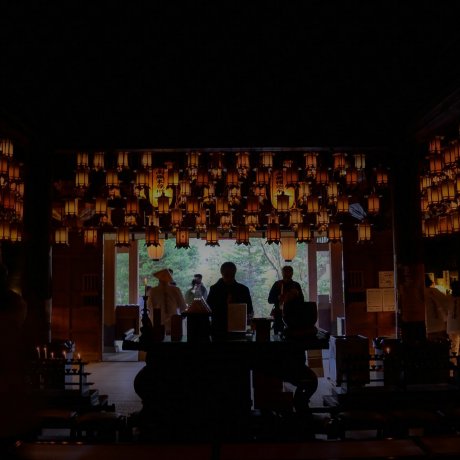 8
8
Ryouzen-ji Temple
Ryouzen-ji Temple is starting point of the Shikoku pilgrimage, and therefore, is always crowded with many travelers and pilgri..
2. Gokurakuji
A quiet residential district temple. Pray here for a smooth pregnancy.
Distance to next: 2.5km
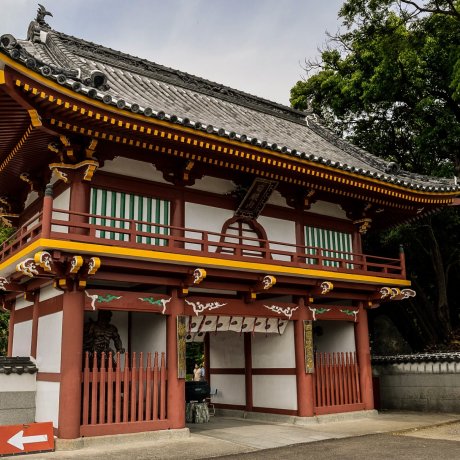 11
11
Shikoku Pilgrimage No. 2&3 Temples
I walked the pilgrimage path to visit the first three temples of the Shikoku Pilgrimage.
3. Konsenji
A temple where you can pray for general improvements to your life.
Distance to next: 5km
4. Dainichiji
Enshrined here are statues related to sacred places in the west.
Distance to next: 2km
 10
10
Shikoku Pilgrimage No. 4&5 Temples
I visited No. 4 and 5 temples of the Shikoku Pilgrimage on foot, and met many Buddhist statues.
5. Jizoji
Bask under the large ginkgo tree bearing over 800 years of history.
Distance to next: 5.3km
6. Anrakuji
Soak in the natural hot spring called Onsen Mountain, a popular stop for pilgrims.
Distance to next: 1km
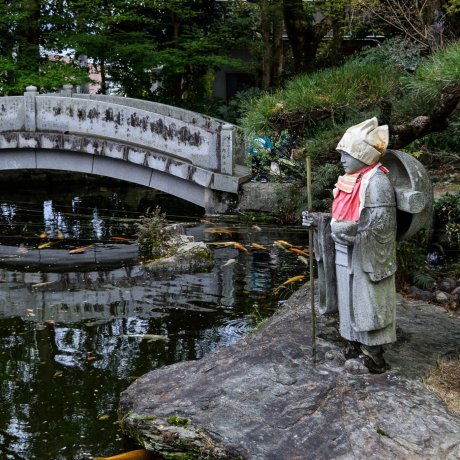 10
10
Shikoku Pilgrimage No. 6&7 Temples
Here on Shikoku Island there is a wonderful culture, 'Osettai", in which pilgrims are treated gently and with respect.
7. Jurakuji
A temple where you can pray for treatment of the eyes.
Distance to next: 4.2km
8. Kumadaniji
This temple has the largest Niomon Gate among the 88 Shikoku temples.
Distance to next: 2.5km
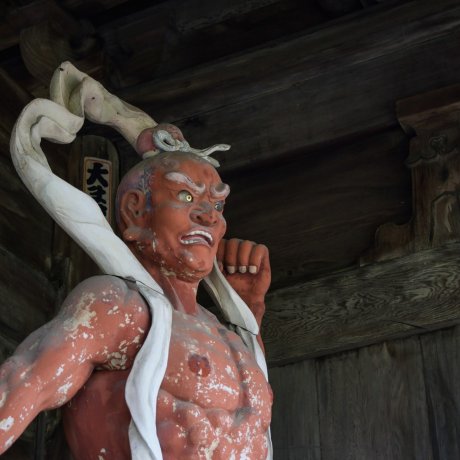 8
8
Shikoku Pilgrimage: Temples No. 8 & 9
The 8th temple (Kumadani-ji) and the 9th temple (Hourin-ji) are located in a residential area. The ninth temple is 6.6 km from..
9. Horinji
A temple that is reputed to heal physical disabilities.
Distance to next: 3.8km
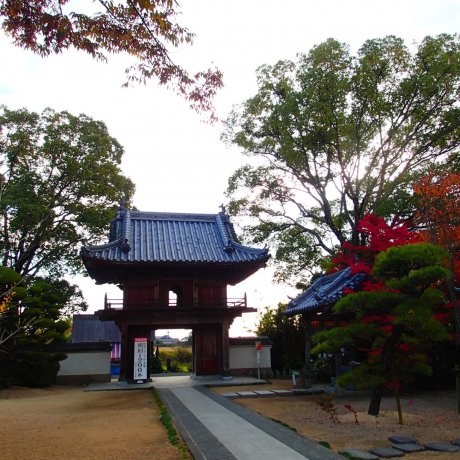 7
7
Horinji
Temple nine in the Shikoku Ohenro pilgrimage is also known as Dharma Wheel Temple. The Main Hall (honzon) is home to the only ..
10. Kirihataji
This temple is popular among women who wish to become good people for its legend about a woman who immediately became a Buddha upon offering Kukai cloth cut from her weaving.
Distance to next: 9.8km
 10
10
Shikoku Pilgrimage: Temple No. 10
As the 10th temple, Kirihata-ji Temple, is on a hill, you can view the way to to it from a distance.
11. Fujiidera
Surrounded by ancient wisteria that blooms in summer; don't miss the ceiling painting of a fearsome dragon. Be careful of the path leading to the temple as it is reputed to be a difficult path for men and women.
Distance to next: 12.5km
 10
10
Shikoku Pilgrimage: Temple No. 11
The first part of the steep mountain path "Henro-michi" starts from the No. 11 temple.
12. Shosanji
Natural monuments of giant ancient cedar trees welcome the pilgrims here. In summer, one can also find plums and sudachi citrus fruits.
Distance to next: 21.5km
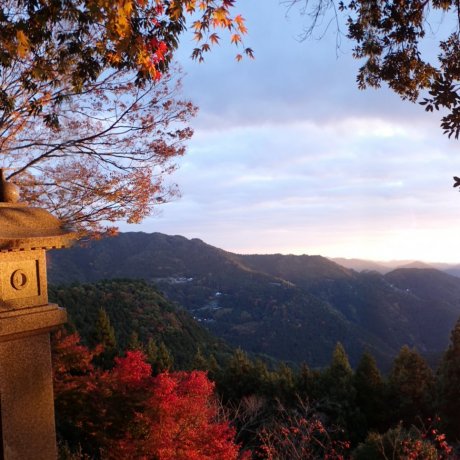 7
7
The Burning Mountain Temple
Temple twelve in the Shikoku Ohenro pilgrimage is also known as the Burning Mountain Temple.
13. Dainichiji
This temple is said to protect the elderly from dementia.
Distance to next: 2.5km
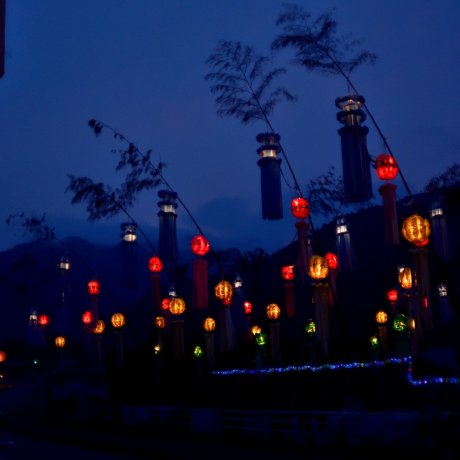 12
12
Shikoku Pilgrimage: Temple No. 13
From the 12th temple to the next one, the walking route is still in a mountainous area.
14. Jorakuji
Araragi Daishi is enshrined here who protects children and heals their pains.
Distance to next: 1km
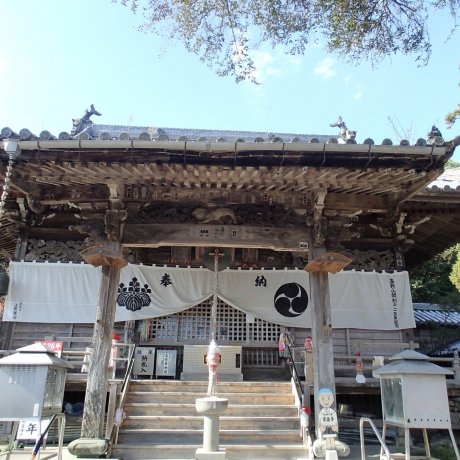 7
7
Jorakuji
Temple fourteen in the Shikoku Ohenro pilgrimage is also known as the Temple of Everlasting Peace
15. Kokubunji
In 2000, the dry garden here was designated as a national scenic garden.
Distance to next: 1.7km
 10
10
Pilgrimage Temples #14,15,16 and 17
Five of the 88 temples of the Shikoku Pilgrimage are located in Tokushima city.
16. Kan-onji
A temple reputed to heal eye ailments and mobility disabilities.
Distance to next: 3km
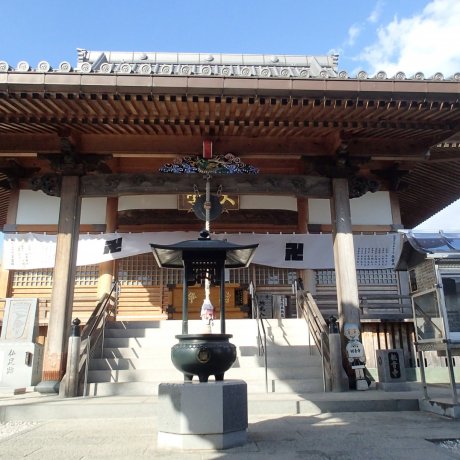 7
7
Kan-onji
Temple sixteen in the Shikoku Ohenro pilgrimage is also known as the Avalokitesvara Temple.
17. Idoji
Look at your reflection in the well dug by Kobo Daishi and you'll be safe from disease and illness for 3 years.
Distance to next: 19km
18. Onzanji
A temple that welcomed women during a ban upon their entry.
Distance to next: 4km
 10
10
Shikoku Temples #18 and #19
Trekking the 18th (Onzan-ji) and 19th (Ritsue-ji) temples of the 88 temple pilgrimage in Shikoku. There is a rest station at Ritsue-ji..
19. Tatsueji
This temple has a legend of a woman who confessed her sins. Upon confession, her hair stood on end and got caught on the bell of the temple.
Distance to next: 14km
20. Kakurinji
The long, arduous trek to this temple's main gate is marked by 11 checkpoint stones and smaller temples. It is also home to the oldest cobblestone in Tokushima and a three-story pagoda.
Distance to next: 6.5km
 10
10
Shikoku Pilgrimage: Temple No. 20
Around the 20th and 21st temples of the Shikoku temple pilgrimage are a number of pilgrim paths. It seems there is an ancient road..
21. Tairyuuji
Ride a ropeway to the summit in order to visit this temple. Enjoy the majestic sights of nature around you.
Distance to next: 12km
 10
10
Shikoku Pilgrimage No. 21 Temple
No. 21 Temple (Tairyu-ji Temple) of the Shikoku pilgrimage is on a mountain.
22. Byodoji
The temple heals people's hearts and bodies from disease. If you approach the temple slowly while gazing at the statue of Buddha, it is said you will be healed.
Distance to next: 21km
23. Yakuoji
The final stop in Tokushima. It is said that praying and offering a tithe at this temple will release you from bad karma.
Distance to next: 83.5km
 11
11
Yakuoji: Temple 23 of Pilgrimage
Yakuoji, No. 23 Temple of Shikoku Pilgrimage is the place to go to ward off bad luck
Discipline yourself in Kochi Prefecture: Temples 24–39
24. Hotsumisakiji
The ancient Tosa district's first ascetic training dojo and a nationally designated important cultural property.
Distance to next: 7km
 8
8
Hotsumisakiji
Temple twenty four in the Shikoku Ohenro pilgrimage is also known as the Cape Temple.
25. Shinshoji
A temple overlooking Murotsu Port, Cape Gonto, and the Pacific Ocean.
Distance to next: 4km
 6
6
Shinshoji
Temple twenty five in the Shikoku Ohenro pilgrimage is also known as the Temple of the Illuminating Seaport.
26. Kongochoji
This temple enshrines many important cultural properties; one such item is a kettle that Kobo Daishi used to save people from hunger.
Distance to next: 30.5km
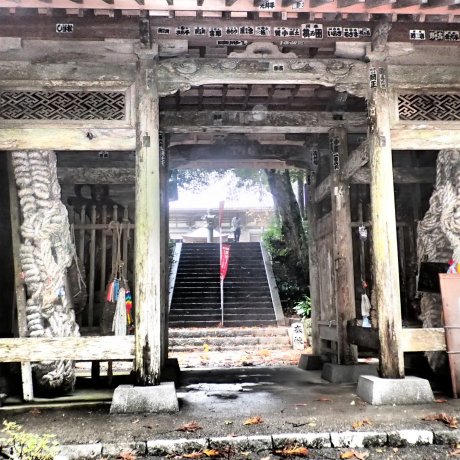 8
8
Kongochoji
Temple twenty six in the Shikoku Ohenro pilgrimage is also known as Vajra Peak Temple.
27. Konomineji
Enjoy the beautifully landscaped gardens are this temple and listen to the warbler birds singing.
Distance to next: 38.5km
 8
8
Konomineji Temple
Temple twenty seven in the Shikoku Ohenro pilgrimage is also known as the God Summit Temple.
28. Dainichiji
This temple was refurbished in 1997 using only wood, there are no nails holding the temple together.
Distance to next: 9km
 7
7
Dainichiji - Konan City
Temple twenty eight in the Shikoku Ohenro pilgrimage is also known the Great Sun Temple.
29. Kokubunji
The simple temple's beauty lies in the nature that decorates it at the changing of each season.
Distance to next: 7km
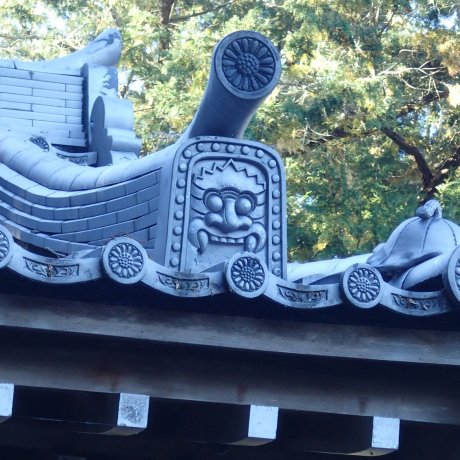 6
6
Kokubunji - Nankoku City
Temple twenty nine in the Shikoku Ohenro pilgrimage is the official Temple of Kochi prefecture.
30. Zenrakuji
The Jizo stone statue here is said to grant relief from sickness of the throat and brain.
Distance to next: 7.5km
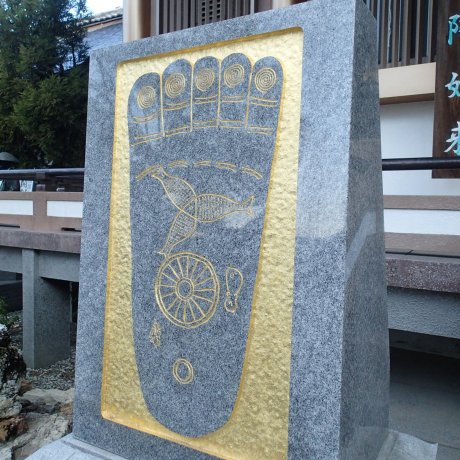 7
7
Zenrakuji
Temple thirty in the Shikoku Ohenro pilgrimage is also known as the Temple of Everlasting Joy.
31. Chikurinji
Visit the only five-storied pagoda in the prefecture and have a view of Kochi from the temple grounds.
Distance to next: 6km
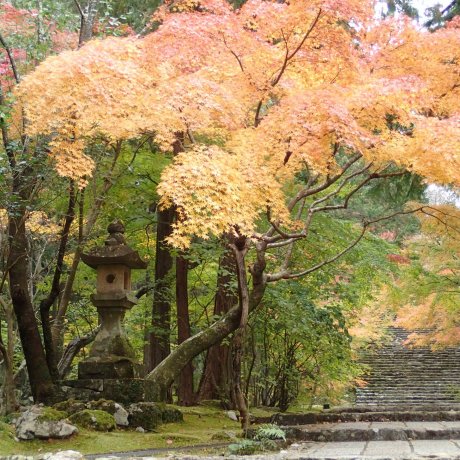 8
8
Chikurinji
Temple thirty one in the Shikoku Ohenro pilgrimage is also known as the Bamboo Forest Temple.
32. Zenjibuji
Prayers at this temple are made in hopes of safe travels, especially sea travels.
Distance to next: 7.5km
 8
8
Zenjibuji
Temple thirty two in the Shikoku Ohenro pilgrimage is also known as the Temple of Ch'an Master's Peak.
33. Sekkeiji
Destroyed once during the Buddhism-purge at the beginning of the Meiji Restoration, this temple is also known as the Snowy Cliff Temple.
Distance to next: 6.5km
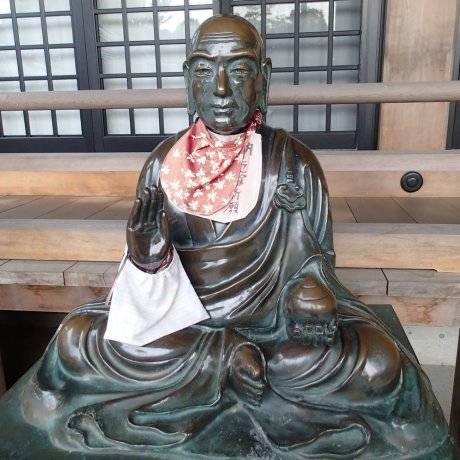 7
7
Sekkeiji
Temple thirty three in the Shikoku Ohenro pilgrimage is also known as the Snowy Cliff Temple.
34. Tanemaji
Bottomless wooden ladles are sold at this temple to pray for a safe birth; once the birth is finished, the ladles are returned to the temples.
Distance to next: 9.5km
 8
8
Tanemaji
Temple thirty four in the Shikoku Ohenro pilgrimage is also known as the Sowing Seeds Temple.
35. Kiyotakiji
A famous temple where you can pray for bad luck and ill omens to disappear from your life.
Distance to next: 15km
 10
10
Kiyotakiji
Temple thirty five in the Shikoku Ohenro pilgrimage is also known as the Clean Waterfall Temple
36. Shoryuji
Also known as the Green Dragon Temple for its deity carving by Kobo Daishi, the statue is the guardian of fishermen.
Distance to next: 55.5km
 7
7
Shoryuji
Temple thirty six in the Shikoku Ohenro pilgrimage is also known as the Green Dragon Temple.
37. Iwamotoji
A mandala of 575 individual paintings makes up the ceiling of this temple.
Distance to next: 86.5km
38. Kongofukuji
It is said that the pond on this temple's grounds is the closest connection to where Kannon lives.
Distance to next: 56km
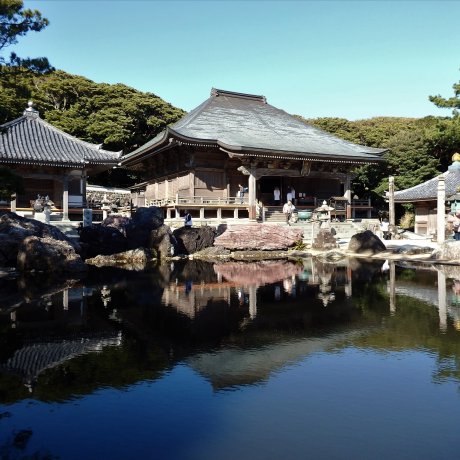 9
9
Kongofukuji Temple at Cape Ashizuri
Kongofukuji is the 38th temple along Shikoku's 88 Sacred Temple Pilgrimage. Located at Cape Ashizuri, it is one of the most..
39. Enkoji
The original bell of this temple is enshrined within. To the right of the entrance, there is medicinal water said to cure eye diseases.
Distance to next: 30km
Attain enlightenment in Ehime Prefecture: Temples 40–65
40. Kanjizaiji
A temple where you can pray to your zodiac guardian.
Distance to next: 48km
41. Ryukoji
A temple surrounded by seasonal flowers; look forward to the Cosmos Festival held every November.
Distance to next: 3km

Ryuko-ji Temple in Uwajima
Ryuko-ji, the Temple of the Dragon’s Light, is temple No. 41 of the 88 sacred temples of the Shikoku pilgrimage. It’s more Shi..
42. Butsumokuji
This temple has long been popular with farmers to pray for the well-being of livestock.
Distance to next: 11km

Butsumoku-ji Temple in Uwajima
Butsumoku-ji, the Temple of the Buddha’s Tree, is temple No. 42 of the 88 sacred temples of the Shikoku pilgrimage. It has an ..
43. Meisekiji
A temple with history dating back to the 6th century, surrounded by an old-growth forest.
Distance to next: 70km
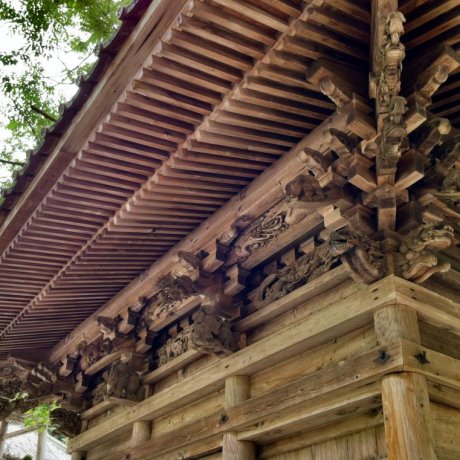
Meiseki-ji in Seiyo
Meiseki-ji is No. 43 on the Shikoku 88 temple pilgrimage. There are dragons in wood and tile, and extra large amounts of moss and..
44. Taihoji
An enshrined gold Kannon statue is enshrined here, believed to be over 1,000 years old.
Distance to next: 9km
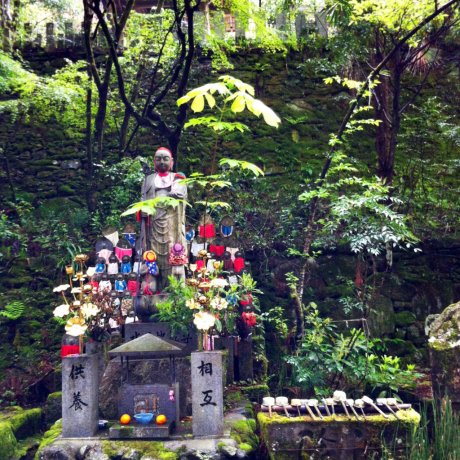
Taiho-ji Temple
Taiho-ji Temple, No. 44 on the Shikoku 88 temple pilgrimage is alive with the awe-inspiring presence of Nature, both ancient and..
45. Iwayaji
This temple, 700 meters above sea level, is embedded in rock and has many gorgeous stone carvings.
Distance to next: 17.5km

Iwaya-ji Temple
If there’s one temple you really should visit in Ehime, Iwaya-ji is it. Its location against a pock-marked cliff inspires awe.
46. Joruriji
Find unique stone imprints of Buddha's hands and feet at this temple.
Distance to next: 1km

Joruri-ji Temple in Matsuyama
Joruri-ji – Temple No. 46 on the Shikoku 88 temple pilgrimage has ancient trees and a beautiful garden. Standing alone in farm..
47. Yasakaji
The "helping hand" stone is found at the 10th step from the bottom of the stone steps. It's said to heal your troubles, foot, and eye diseases.
Distance to next: 4.5km
48. Sairinji
The small bamboo grove here is said to be a symbol of family well-being.
Distance to next: 3km

Sairin-ji Temple in Matsuyama
Sairin-ji Temple, No.49 of the 88 sacred temples of Shikoku, stands in well-manicured grounds
49. Jodoji
Find Muromachi-era graffiti on the temple walls for a tidbit of history.
Distance to next: 1.5km
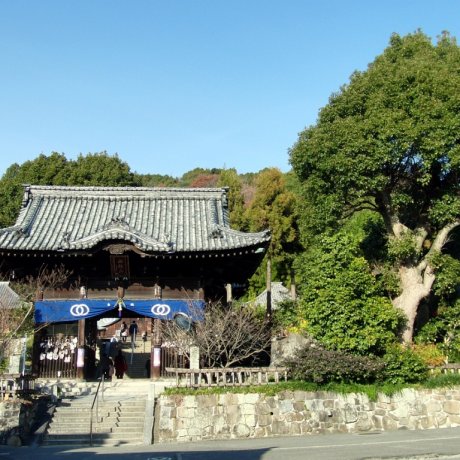
Jodo-ji Temple in Matsuyama
Jodo-ji Temple, No.49 of the 88 sacred temples of Shikoku, has a rustic, weathered air.
50. Hantaji
Pray at this temple for wealth, luck, marital harmony, and prosperous business.
Distance to next: 2.5km
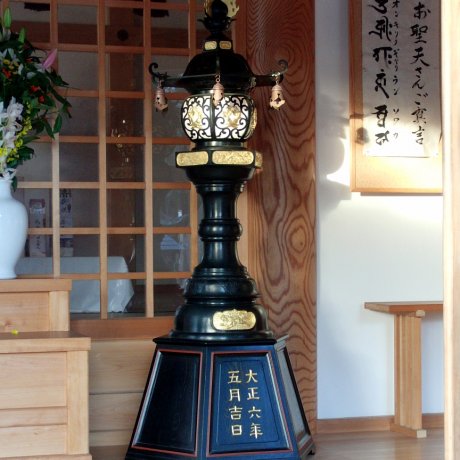
Hanta-ji Temple
Hanta-ji Temple, No. 50 of the 88 sacred temples of Shikoku, offers a sweeping view over south Matsuyama
51. Ishiteji
Receive a power stone from this temple, famous for the phrase, "fall down seven times, get up eight."
Distance to next: 10.5km
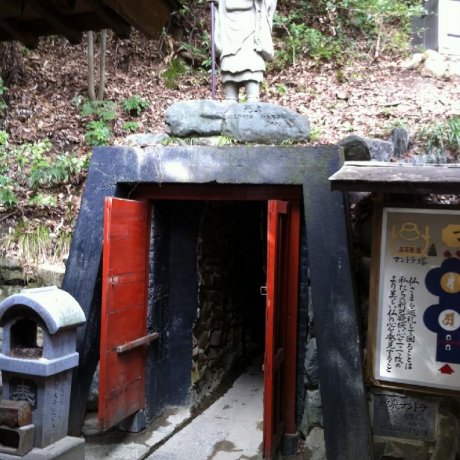
Ishite-ji Temple in Matsuyama
Ishite Temple is a weird place. Ishite-ji, as it's known in Japanese, is No. 51 of the 88 temples that form the Shikoku Pilgrimage...
52. Taisanji
It is said that visiting this temple ensures that you will not suffer in your next life.
Distance to next: 2km
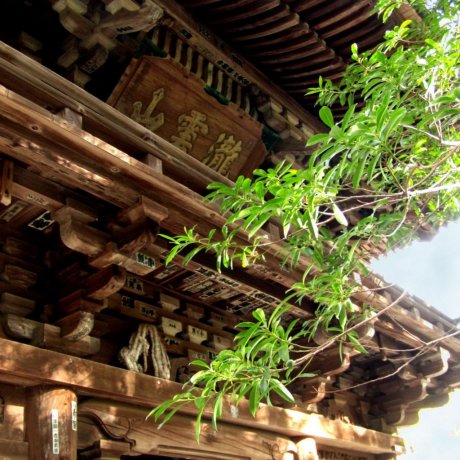
Taisan-ji Temple in Matsuyama
Taisan-ji is a temple in Matsuyama. It’s No. 52 on the Shikoku pilgrimage. It sits on a hillside isolated from the city, surro..
53. Enmyoji
It is believed that when a bad person looks upon the dragon statue here, the eyes will light up.
Distance to next: 34.5km

Enmyo-ji in Matsuyama
Enmyo-ji is a Shingon temple in Matsuyama. It’s temple No. 53 on the pilgrimage of 88 temples around Shikoku. It has some beau..
54. Enmeiji
A temple that has endured many fires and has been rebuilt many times.
Distance to next: 3.6km
55. Nankobo
The temple houses the sedge hat of Kawamura Kizan who won the first Art Academy Prizes for calligraphy.
Distance to next: 3.1km
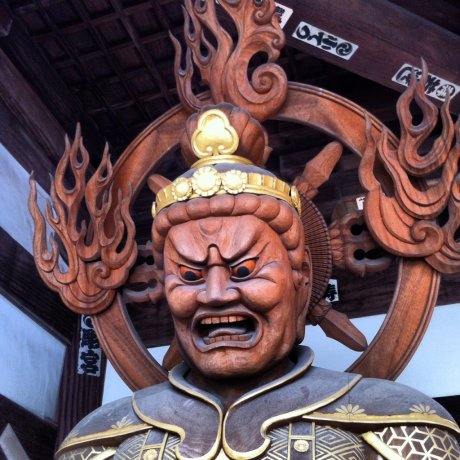
Nankobo Temple
Nankobo is Temple No. 55 of the Shikoku 88 temple pilgrimage. It’s one of the biggest of the 88 temples. It stands in central ..
56. Taisanji
A temple where one can pray to calm the spirits of people who have lost their lives due to floods.
Distance to next: 3km

Taisan-ji Temple in Imabari
Taisan-ji is Temple No. 56 of the Shikoku 88 temple pilgrimage. It stands on a platform constructed of massive stones reminiscent..
57. Eifukuji
In 1958, a physically disabled 15-year-old boy visited the temple and had his legs healed. Today, his cart and crutches remain at the temple.
Distance to next: 2.5km

Eifuku-ji Temple
Eifuku-ji is Temple No. 57 of the Shikoku 88 temple pilgrimage. A small temple, it stands in a forest of bamboo with attractive..
58. Senyuji
The temple often houses pilgrims for the night, reservations are required.
Distance to next: 6.2km

Senyu-ji Temple
Senyu-ji is a temple in Imabari. It’s temple No. 58 on the pilgrimage of 88 temples around Shikoku, and one of the more impres..
59. Kokubunji
Visit in early April to see the Chinese camellia flowers in full bloom.
Distance to next: 33km

Kokubun-ji Temple in Imabari
Kokubun-ji, Temple No.59, is the temple for the province of Iyo, in the system of provincial temples established by Emperor Sh..
60. Yokomineji
This temple is located on the highest peak in the area, Mt. Ishizuchi, and is a sacred place for training and mountain worship.
Distance to next: 10km
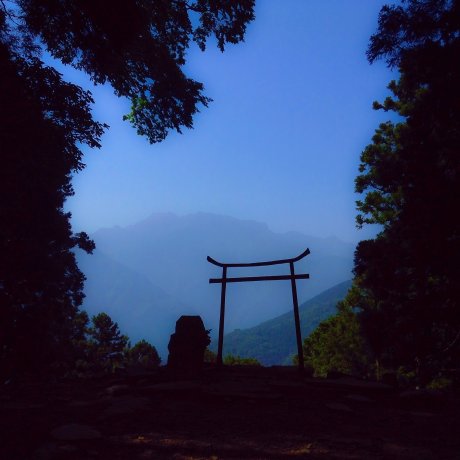 8
8
Steep Path to Yokomine-ji Temple
Last summer, I walked the steep path from Yunami to Yokomine-ji temple.
61. Ko-onji
A part of this temple, erected in 1950, was dedicated to school education.
Distance to next: 1.5km
 7
7
Koonji no Okunoin Temple
A deeper enclave of Koonji, temple No.61 of the Shikoku Pilgrimage where you can get a stamp for your book, and practice some classic..
62. Hojuji
This temple is popular for prayers of national peace, wish fulfillment, and protection during childbirth.
Distance to next: 1.4km

Hoju-ji Temple in Saijo
Hoju-ji is No. 62 on the Shikoku 88 temple pilgrimage. It's the Temple of Wealth and Happiness, but it doesn’t look like it.
63. Kichijoji
Pass under the Kikuri Kichijoten statue to rid yourself of poverty and receive wealth.
Distance to next: 3.5km

Kichijo-ji Temple in Saijo
Kichijo-ji is No. 63 on the Shikoku 88 temple pilgrimage. This temple is unique in having one of the Seven Lucky Gods as its tutelary..
64. Maegamiji
Visit July 1st to experience the Opening of the Mountains, white robes are laid upon the ground and conch shells are blown.
Distance to next: 45km

Maegami-ji Temple in Saijo
Maegami-ji, Temple No.64, stands in the foothills of Mt. Ishizuchi, the highest mountain of western Japan. This temple could almost..
65. Sankakuji
This temple is said to cure warts and corns on the feet. Dedicated a votive picture of an octopus and pray and the suckers will remove the corns from your feet.
Distance to next: 20.5km
Find the path to nirvana in Kagawa Prefecture: Temples 66–88
66. Unpenji
The 500-life size Buddha's apprentices statues create a holy atmosphere.
Distance to next: 13.5km
67. Daikoji
The main hall of this temple is filled with red candles. They remain lit for 7 days to pray for healing, safe birth, and goodwill to others.
Distance to next: 9km
68. Jinnein
Be sure to view the garden here with its lovely flowing waters, rocks, and delicate slopes.
Distance to next: 0.5km
69. Kan-nonji
The temple is said to house the oldest graffiti in Japan. There are also beautiful painted wooden panels.
Distance to next: 4.7km
70. Motoyamaji
The Nara-era-style five-storied pagoda here is a designated national treasure.
Distance to next: 12.2km
71. Iyadaniji
Lion-shaped stones here are heavily tied to the Buddhist faith as they are believed to be similar to Buddha's preaching.
Distance to next: 4km

Shikoku Pilgrimage's Mairi Path
About Temples 71-77 which form the Mairi Path, and its origins, Iyadani-ji. A sad story but henro are happy coming closer to Nirvana...
72. Mandaraji
The wooden sculptures at this temple are considered to be holy relics.
Distance to next: 0.4km
73. Shusshakuji
A 50-minute climb from the temple grounds, the pilgrimage hall is home to prayer on the 15th day each month and offers stunning views.
Distance to next: 2.5km
74. Koyamaji
This temple protects against anything that harms the body or mind and provides powerful blessings to its visitors.
Distance to next: 1.5km
75. Zentsuji
In the basement of the Mikagedo building, there is a passage spanning 100 meters in absolute darkness.
Distance to next: 2.3km
76. Konzoji
The 1st Saturday and Sunday in September see a fire-walking festival that general worshipers can also participate in.
Distance to next: 3.9km
77. Doryuji
Over 200 Kannon statues line this temple, they are placed for unborn children and travel safety.
Distance to next: 7.1km
78. Goshoji
About 10,000 miniature statues of Kannon are enshrined here to fulfill the wishes of pilgrims.
Distance to next: 6.3km
79. Tennoji
The stone waterfall facade here is considered holy and makes for a striking image.
Distance to next: 6.3km
80. Kokubunji
This temple houses the oldest temple bell in Shikoku. It is the subject of many legends.
Distance to next: 6.7km
81. Shiromineji
Famous for its many events throughout the year, this temple also has fantastic seasonal flowers.
Distance to next: 4.6km
82. Negoroji
There is a legend of the bull devil at this temple. It once terrorized the local community and was slain by a bow master who dedicated the beast's horn to the temple.
Distance to next: 13.3km
83. Ichinomiyaji
The Hell's Cauldron at this temple is said to differentiate between those living a good life or a bad one. Put your head inside and if you cannot remove it, you should repent for your bad deeds.
Distance to next: 13.7km
84. Yashimaji
The Yashima Temple Museum is to the left of this temple and provides history and a preserved look at many treasures.
Distance to next: 7.2km
85. Yakuriji
This temple is said to be protected by a good tengu who performs good deeds for the people. If the wooden clogs at the temple are dirty, it is said that the tengu worked hard the night before.
Distance to next: 6.5km
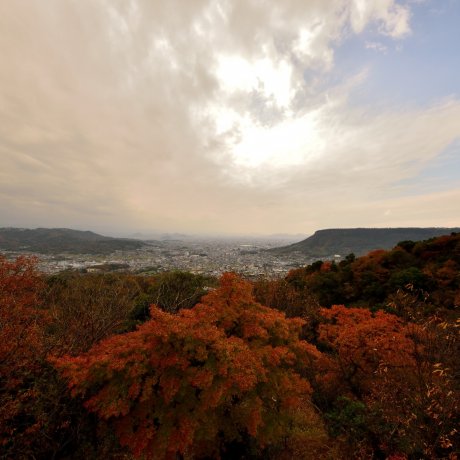 10
10
Shikoku Temple #85: Yakuriji
One of the 88 temples on a pilgrimage around Japan's Shikoku island, Yakuri Temple is also close to a famous "Sanuki Udon" noodle..
86. Shidoji
This temple was once the stage for the tragic deaths of the Fujiwara family and is the setting for famous Noh plays about the subject.
Distance to next: 7km
87. Nagaoji
A temple that has survived and escaped several fires throughout history. It is considered to be very lucky.
Distance to next: 15.6km
88. Okuboji
There are 88 small shrines here. they are said to have the same effect as visiting all Shikoku 88 temples in person.
Distance to next: 38.5km


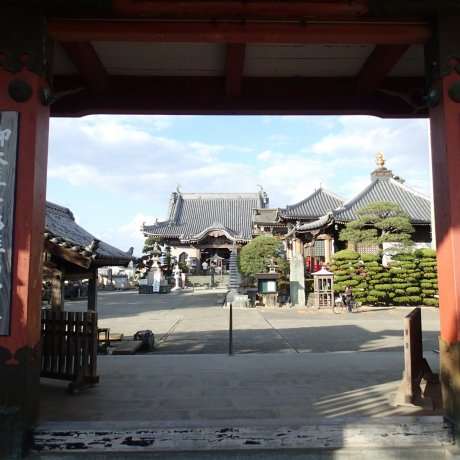
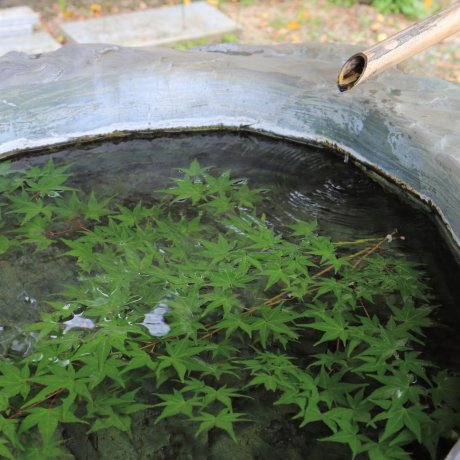

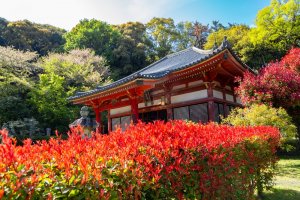


























When I spent some time in Shikoku, my friends and I made a game of Ohenro-san spotting on the roads. A lot of them wear the sedge hats and white vests, so they're easy to spot. We helped them out when we could with directions and bottled drinks.